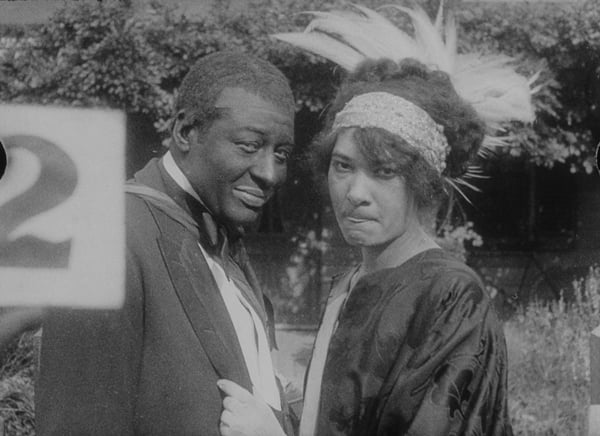
Photo: Museum of Modern Art, New York.
Scene still Bert Williams Lime Kiln Field Day Project. Bert Williams, Walker Thompson (standing center), John Wesley Jenkins (seated right).
Photo: Courtesy the Museum of Modern Art, New York.
Curators at the Museum of Modern Art finally got around to watching seven reels of film that its founding film curator, Iris Barry, acquired along with the rest of the Bronx-based Biograph Studio archive in 1939, and have found what may be the earliest feature film starring a black cast. The footage is a collection of unedited footage from 1913, so-called rushes, from a film starring the Caribbean American musician and performer Bert Williams. The unfinished film will finally have its premiere, 101 years later, at MoMA, as part of its “To Save and Project” series, on November 8.
“Although Bert Williams’s little-known film career took place in the blink of an eye, I consider him a performer worthy of comparison to Charles Chaplin,” MoMA’s associate film curator Ron Magliozzi said in a statement. “The footage had been catalogued noting Williams’s appearance, but it wasn’t until we passed over it frame by frame on a stop-motion editing table that its significance truly blossomed.”
Scene still Bert Williams Lime Kiln Field Day Project. From left to right: Bert Williams, Odessa Warren Grey, unidentified, Walker Thompson.
Photo: Museum of Modern Art, New York.
Without the benefit of credits, a script, production notes, or intertitles, Magliozzi and film department preservation officer Peter Williamson sought to reassemble the footage into a comedy centered on Williams’s attempts to gain membership to a black social club while also competing for the affections of a young woman in his neighborhood. The curators even hired a professional lip reader to help deduce any plot details from the dialogue, which they discovered to have been improvised. The reels also include documentary footage of the mostly black cast—a group of 50 to 100 Harlem-based recording artists, actors, and dancers—and mostly white crew interacting between takes.
The film was shot at the same time as D.W. Griffith’s Birth of a Nation, but juxtaposes similarly racist portrayals of black character—it includes frequent uses of minstrelsy—with contemporaneous dance crazes and a rare romance between black characters, complete with Williams and his co-star Odessa Warren Grey kissing repeatedly.
Production still from Bert Williams Lime Kiln Field Day Project. Bert Williams and Odessa Warren Grey.
Photo: Museum of Modern Art, New York.
“It’s an interracial production, but not in the way scholars have talked about early film history, in which black filmmakers had to rely on the expertise and money of white filmmakers,” University of Chicago film scholar Jacqueline Stewart told the New York Times. “Here, we see a negotiation between performers and filmmakers.”
The first screening of Bert Williams Lime Kiln Field Day Project will be accompanied by an exhibition on the restoration and reconstruction process, “100 Years in Post-Production: Resurrecting a Lost Landmark of Black Film History,” in MoMA’s film galleries from October 24 through March 2015.